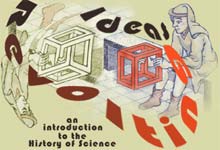
University of California, Irvine
Instructor: Dr. Barbara J. Becker

|
Week 4. Heavenly Reading Dialogue Concerning the Two Chief World Systems (1632)
|
During the course of three days of discussion, Salviati (representing Galileo), Simplicio (representing the Aristotelian perspective), and Sagredo (representing the interested public) thoroughly air all the available evidence and arguments bearing on the understanding of mechanics and the structure and nature of the universe.
| Salviati: | We shall next consider the annual movement generally attributed to the sun, but then, first by Aristarchus of Samos and later by Copernicus, removed from the sun and transferred to the earth. Against this position I know that Simplicio comes strongly armed, in particular with the sword and buckler of his booklet of theses or mathematical disquisitions. It will be good to commence by producing the objections from this booklet. |
| Simplicio: | If you don't mind, I am going to leave those for the last, since they were the most recently discovered. |
| Salviati: | Then you had better take up in order, in accordance with our previous procedure, the contrary arguments by Aristotle and the other ancients. I also shall do so, in order that nothing shall be left out or escape careful consideration and examination. Likewise Sagredo, with his quick wit, shall interpose his thoughts as the spirit moves him. |
| Sagredo: | I shall do so with my customary lack of tact; and since you have asked for this, you will be obliged to pardon it. |
| Salviati: | This favor will oblige me to thank and not to pardon you. But now let Simplicio begin to set forth those objections which restrain him from believing that the earth, like the other planets, may revolve about a fixed center. |
| Simplicio: | The first and greatest difficulty is the repugnance and incompatibility between being at the center and being distant from it. For if the terrestrial globe must move in a year around the circumference of a circle--that is, around the zodiac--it is impossible for it at the same time to be in the center of the zodiac. But the earth is at that center, as is proved in many ways by Aristotle, Ptolemy, and others. |
| Salviati: | Very well argued. There can be no doubt that anyone who wants to have the earth move along the circumference of a circle must first prove that it is not at the center of that circle. The next thing is for us to see whether the earth is or is not at that center around which I say it turns, and in which you say it is situated. And prior to this, it is necessary that we declare ourselves as to whether or not you and I have the same concept of this center. Therefore tell me what and where this center is that you mean. |
| Simplicio: | I mean by "center," that of the universe; that of the world; that of the stellar sphere; that of the heavens. |
| Salviati: | I might very reasonably dispute whether there is in nature such a center, seeing that neither you nor anyone else has so far proved whether the universe is finite and has a shape, or whether it is infinite and unbounded. Still, conceding to you for the moment that it is finite and of bounded spherical shape, and therefore has its center, it remains to be seen how credible it is that the earth rather than some other body is to be found at that center. |
| Simplicio: | Aristotle gives a hundred proofs that the universe is finite, bounded, and spherical. |
| Salviati: | Which are later all reduced to one, and that one to none at all.
For if I deny him his assumption that the universe is moveable all his
proofs fall to the ground, since he proves it to be finite and bounded
only if the universe is movable. But in order not to multiply our
disputes, I shall concede to you for the time being that the universe is
finite, spherical, and has a center. And since such a shape and center
are deduced from mobility, it will be the more reasonable for us to proceed
from this same circular motion of world bodies to a detailed investigation
of the proper position of the center. Even Aristotle himself reasoned
about and decided this in the same way, making that point the center of
the universe about which all the celestial spheres revolve, and at which
he believed the terrestrial globe to be situated.
Now tell me, Simplicio: if Aristotle had found himself forced by the most palpable experiences to rearrange in part this order and disposition of the universe, and to confess himself to have been mistaken about one of these two propositions--that is, mistaken either about putting the earth in the center, or about saying that the celestial spheres move around such a center--which of these admissions do you think that he would choose? |
| Simplicio: | I think that if that should happen, the Peripatetics... |
| Salviati: | I am not asking the Peripatetics; I am asking Aristotle himself. As for the former, I know very well what they would reply. They, as most reverent and most humble slaves of Aristotle, would deny all the experiences and observations in the world, and would even refuse to look at them in order not to have to admit them, and they would say that the universe remains just as Aristotle has written; not as nature would have it. For take away the prop of his authority, and with what would you have them appear in the field? So now tell me what you think Aristotle himself would do. |
| Simplicio: | Really, I cannot make up my mind which of these two difficulties he would have regarded as the lesser.... |
| Salviati: | [S]ince you do not know to which side [Aristotle] would have leaned, and considering him as I do a man of brilliant intellect, let us set about examining which of the two choices is the more reasonable... |
| Simplicio: | I should think it would be much more reasonable to say that the container and the things it contained all moved around one common center rather than different ones. |
| Salviati: | Now if it is true that the center of the world is that point around which all the orbs and world bodies (that is, the planets) move, it is quite certain that not the earth, but the sun, is to be found at the center of the universe. Hence, as for this first general conception, the central place is the sun's, and the earth is to be found as far away from the center as it is from the sun. |
| Simplicio: | How do you deduce that it is not the earth, but the sun, which is at the center of the revolutions of the planets? |
| Salviati: | This is deduced from the most obvious and therefore most powerfully convincing observations. The most palpable of these, which excludes the earth from the center and places the sun there, is that we find all the planets closer to the earth at one time and farther from it at another. The differences are so great that Venus, for example, is six times as distant from us at its farthest as at its closest, and Mars soars nearly eight times as high in the one state as in the other. You may thus see whether Aristotle was not some trifle deceived in believing that they were always equally distant from us. |
| Simplicio: | But what are the signs that they move around the sun? |
| Salviati: | This is reasoned out from finding the three outer planets--Mars, Jupiter and Saturn--always quite close to the earth when they are in opposition to the sun and very distant when they are in conjunction with it. This approach and recession is of such moment that Mars when close looks sixty as large as when it is most distant. Next, it is certain that Venus and Mercury must revolve around the sun, because of their never moving far away from it, and because of their being seen now beyond it and now on this side of it, as Venus's changes of shape conclusively prove. As to the moon, it is true that this can never separate from the earth in any way, for reasons that will be set forth more specifically as we proceed. |
| Sagredo: | I have hopes of hearing still more remarkable things arising from this annual motion of the earth than were those which depended upon its diurnal rotation. |
| Salviati: | You will not be disappointed, for as to the action of the diurnal motion
upon celestial bodies, it was not and could not be anything different from
what would appear if the universe were to rush speedily in the opposite
direction. But this annual motion, mixing with the individual motions
of all the planets, produces a great many oddities which in the past have
baffled all the greatest men in the world.
Now returning to these first general conceptions, I repeat that the center of the celestial rotation for the five planets, Saturn, Jupiter, Mars, Venus, and Mercury, is the sun; this will hold for the earth too, if we are successful in placing that in the heavens. Then as to the moon, it has a circular motion around the earth, from which as I have already said it cannot be separated; but this does not keep it from going around the sun along with the earth in its annual movement. |
| Simplicio: | I am not yet convinced of this arrangement at all. Perhaps I should understand it better from the drawing of a diagram, which might make it easier to discuss. |
| Salviati: | That shall be done. But for your greater satisfaction and your astonishment, too, I want you to draw it yourself. You will see that however firmly you may believe yourself not to understand it, you do so perfectly, and just by answering my questions you will describe it exactly. So take a sheet of paper and the compasses; let this page be the enormous expanse of the universe, in which you have to distribute and arrange its parts as reason shall direct you. And first, since you are sure without my telling you that the earth is located in this universe, mark some point at your pleasure where you intend this to be located and designate it by means of some letter. |
| Simplicio: | Let this be the place of the terrestrial globe, marked A. |
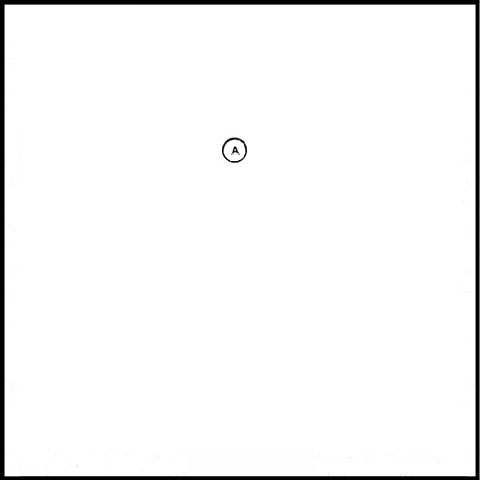 |
|
| Salviati: | Very well, I know in the second place that you are aware that this earth is not inside the body of the sun, nor even contiguous to it, but is distant from it by a certain space. Therefore assign to the sun some other place of your choosing, as far from the earth as you like, and designate that also. |
| Simplicio: | Here I have done it; let this be the sun's position, marked O. |
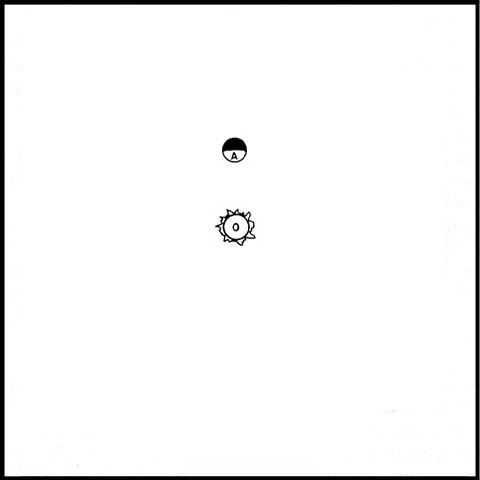 |
|
| Salviati: | These two established, I want you to think about placing Venus in such a way that its position and movement can conform to what sensible experience shows us about it. Hence you must call to mind, either from past discussions or from your own observations, what you know happens with this star. Then assign it whatever place seems suitable for it to you. |
| Simplicio: | I shall assume that those appearances are correct which you have related
and which I have read also in the booklet of theses; that is, that this
star never recedes from the sun beyond a certain definite interval of forty
degrees or so; hence it not only never reaches opposition to the sun, but
not even quadrature, nor so much as a sextile aspect. Moreover, I
shall assume that it displays itself to us about forty times as large at
one time than at another ... and furthermore that when it appears very
large, it reveals itself in a horned shape, and when it looks very small
it appears perfectly round.
These appearance being correct, I say, I do not see how to escape affirming that this star revolves in a circle around the sun, in such a way that this circle cannot possibly be said to embrace and contain within itself the earth, nor to be ... between the sun and the earth, nor yet beyond the sun. Such a circle cannot embrace the earth because then Venus would sometimes be in opposition to the sun; it cannot be [between the sun and the earth] for then Venus would appear sickle-shaped at both conjunctions; and it cannot be beyond the sun, since then it would always look round and never horned. Therefore for its lodging I shall draw the circle CH around the sun, without having this include the earth. |
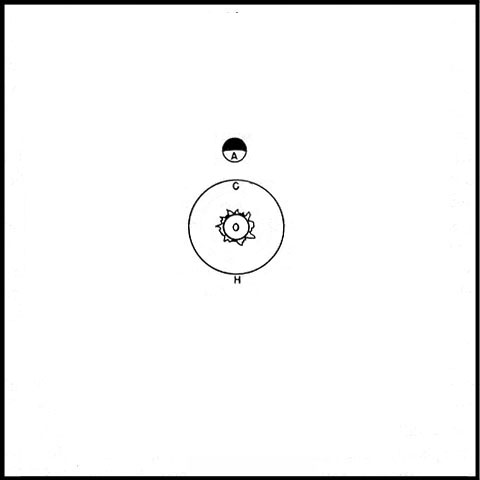
[Through similar reasoning, Simplicio positions Mercury on a smaller circle, BG, around the sun.] |
|
| Salviati: | Next, where shall we put Mars? |
| Simplicio: | Mars, since it does come into opposition with the sun, must embrace the earth with its circle. And I see that it must also embrace the sun; for, coming into conjunction with the sun, if it did not pass beyond it ... it would appear horned as Venus and the moon do. But it always looks round; therefore its circle must include the sun as well as the earth. And since I remember your having said that when it is in opposition to the sun it looks sixty times as large as when in conjunction, it seems to me that this phenomenon will be well provided for by a circle around the sun embracing the earth, which I draw here and mark DI. When Mars is at the point D, it is very near the earth and in opposition to the sun, but when it is at the point I, it is in conjunction with the sun and very distant from the earth. |
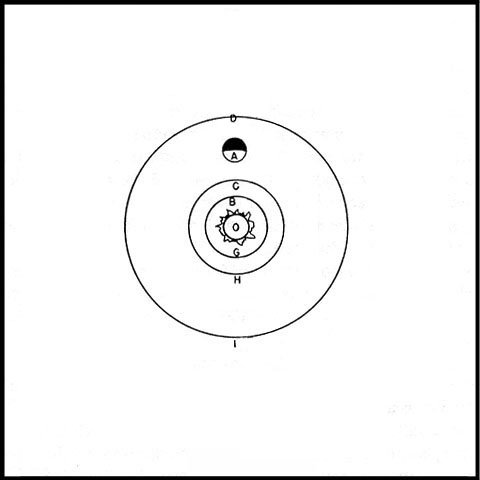
[Through similar reasoning, Simplicio positions Jupiter on a larger circle, EL, and Saturn on a still larger circle, FM.] |
|
| Simplicio: | Following the same method (which seems to me very convincing), since we see the moon come into conjunction and opposition with the sun, it must be admitted that its circle embraces the earth. But it must not embrace the sun also, or else when it was in conjunction it would not look horned but always round and full of light. Besides, it would never cause an eclipse of the sun for us, as it frequently does, by getting in between us and the sun. Thus one must assign to it a circle around the earth, which shall be this one, NP, in such a way that when at P it appears to us here on the earth A as in conjunction with the sun, which sometimes it will eclipse in this position. Placed at N, it is seen in opposition to the sun, and in that position it may fall under the earth's shadow and be eclipsed. |
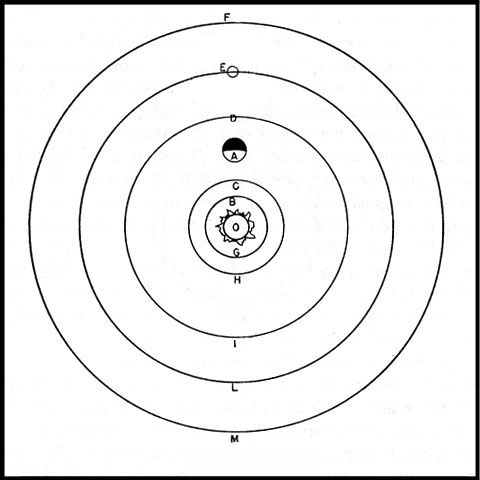
[Simplicio then positions the stars on a very large "universal sphere" which surrounds all the planetary spheres.] |
|
| Salviati: | Well, Simplicio, what we have been doing all this while is arranging
the world bodies according to the Copernican distribution, and this has
now been done by your own hand. Moreover, you have assigned their
proper movements to them all except the sun, the earth and the stellar
sphere....
[A]s to the earth, which is placed in the midst of moving objects--I
mean between Venus and Mars, one of which makes its revolution in nine
months and the other in two years--a motion requiring one year may be attributed
to it much more elegantly than a state of rest, leaving the latter for
the sun. And such being the case, it necessarily follows that the
diurnal motion, too, belongs to the earth. For if the sun stood still,
and the earth did not revolve upon itself but merely had the annual movement
around the sun, our year would consist of no more than one day and one
night; that is, six months of day and six months of night....
|
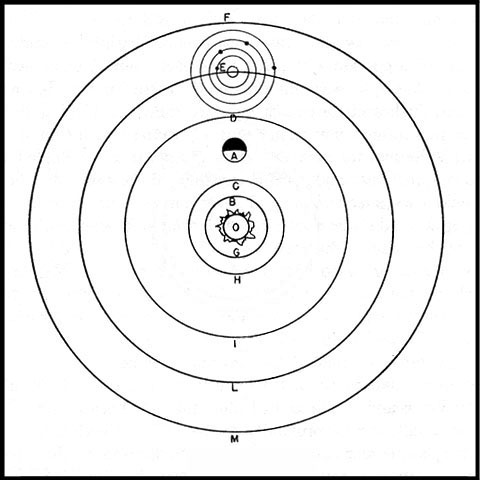 |
|
| It remains for us to remove what would seem to be a great objection to the motion of the earth. This is that though all the planets turn about the sun, the earth alone is not solitary like the others, but goes together in the company of the moon and the whole elemental sphere around the sun in one year, while at the same time the moon moves around the earth every month. Here one must exclaim over and exalt the admirable perspicacity of Copernicus, and simultaneously regret his misfortune at not being alive in our day. For now Jupiter removes this apparent anomaly of the earth and moon moving conjointly. We see Jupiter, like another earth, going around the sun in twelve years accompanied not by one but by four moons, together with everything that may be contained within the orbits of its four satellites. | |
| Sagredo: | And what is the reason for your calling the four Jovian planets "moons"? |
| Salviati: | That is what they would appear to be to anyone who saw them from Jupiter. For they are dark in themselves, and receive their light from the sun; this is obvious from their being eclipsed when they enter into the cone of Jupiter's shadow. And since only that hemisphere of theirs is illuminated which faces the sun, they always look entirely illuminated to us who are outside their orbits and closer to the sun; but to anyone on Jupiter they would look completely lighted only when they were at the highest points of their circles. [W]hen between Jupiter and the sun--they would appear horned from Jupiter. In a word, they would make for Jovians the same changes of shape which the moon makes for us Terrestrials. |
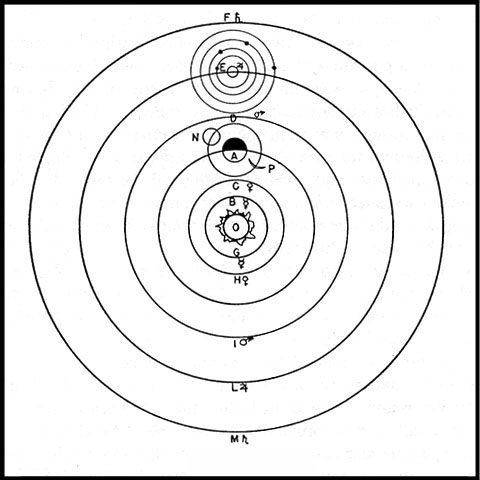 |
|
|